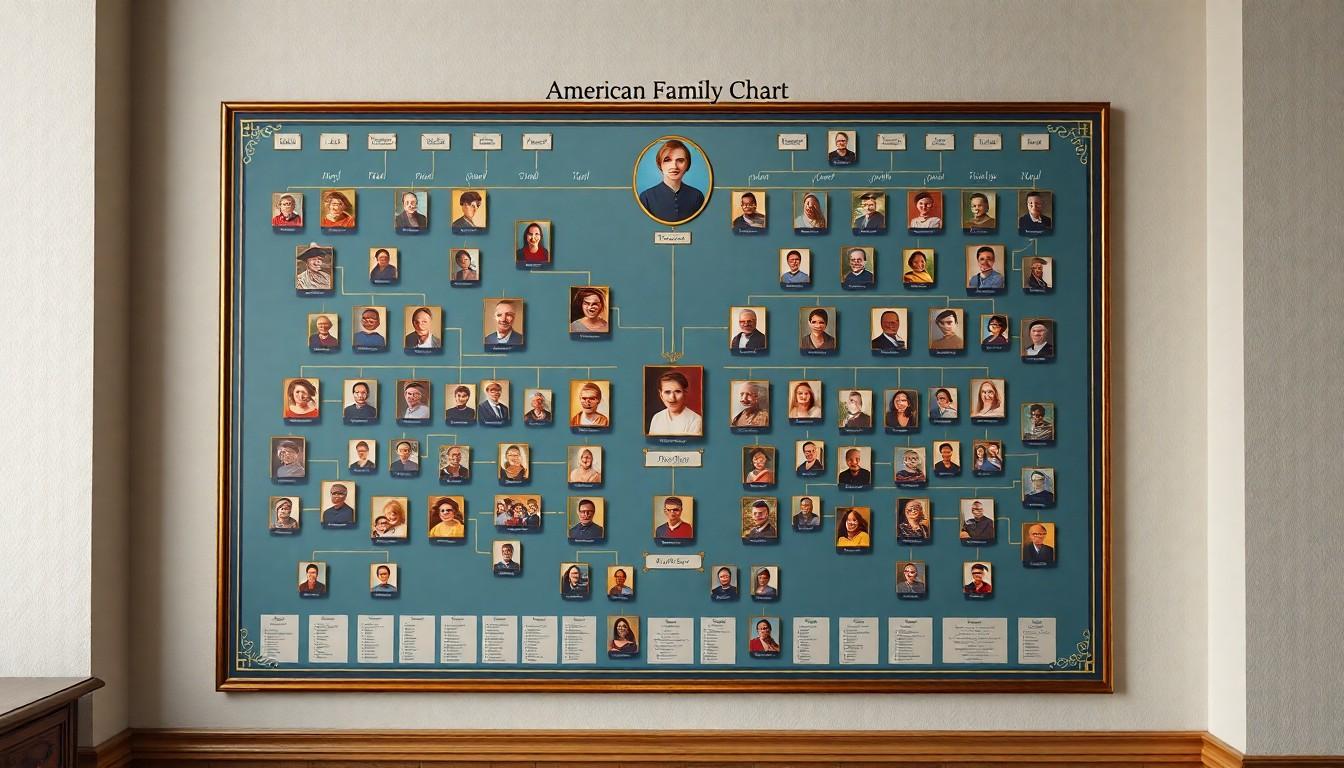Family trees can feel like tangled webs of relationships, but they don’t have to be a mystery. Ever wondered how Aunt Mildred is related to Cousin Joe? Or why Grandma insists on calling your best friend “the nice boy”? A family tree relationships chart can turn that confusion into clarity, making family gatherings a little less like a game of “Guess Who?” and more like a well-rehearsed play.
Family Tree Relationships Chart
Family tree relationships charts provide a visual representation of family connections. Such charts clarify relationships and enhance understanding of lineage.
What Is a Family Tree Relationships Chart?
A family tree relationships chart illustrates familial relationships across generations. It highlights connections between parents, children, siblings, and extended family members. Charts might include various family roles like grandparents and cousins. Typically, users create these charts through genealogy software or by hand. Families can add multiple branches to represent diverse relationships.
Importance of Family Tree Relationships Charts
Understanding family dynamics becomes easier with a family tree relationships chart. These charts offer clarity regarding complex connections, aiding in social interactions during gatherings. Additionally, they help track inheritance and family history. Charting relationships can also unveil new discoveries about ancestry. Families often strengthen their ties by recognizing shared heritage through visual representations.
Types Of Family Trees

Family trees come in various formats, each serving a unique purpose. Understanding these types clarifies how they can represent family relationships.
Traditional Family Trees
Traditional family trees focus on direct lineage. They usually depict ancestors and descendants in a straightforward layout. Generations branch off from a common ancestor, allowing easy tracing of bloodlines. These trees often include names, birth dates, and marriage dates, providing essential historical context. Parents connect directly to their children, making relationships easy to comprehend. Often, traditional formats appear as large charts displayed on paper or wall posters.
Modern Family Tree Charts
Modern family tree charts embrace technology for greater complexity and interactivity. Genealogy websites and software create dynamic digital representations. Users can include a broader range of relationships, such as stepfamilies and adoptions. Visual elements like icons or color coding enhance understanding of connections. These charts often feature clickable elements, allowing exploration of individual stories and documents. Many modern charts support collaboration, enabling family members to contribute their own details seamlessly. Additionally, a beautifully designed printed invitation can be used to invite relatives to family reunions or genealogy events, making the experience even more personal and meaningful.
Creating A Family Tree Relationships Chart
Creating a family tree relationships chart involves careful consideration of various elements. The first step focuses on gathering relevant information about family members.
Gathering Information
Start with direct relatives such as parents, siblings, and children. Collect names, birth dates, and any marriage dates for accuracy. Include details regarding stepfamily and adopted members to provide a comprehensive view. Engage with family members to uncover stories or connections. Documenting oral histories enhances the richness of the familial narrative. Organize the information systematically, ensuring clarity and completeness. Narrow down specific relationships that might require further clarification for easier representation. Ensuring access to records, like birth certificates, also adds depth to the research.
Choosing a Format
Various formats exist for representing family relationships visually. Traditional charts present relationships in a straightforward manner, easily understood by all ages. Digital options offer more versatility and interactivity. Consider if a pedigree format, which emphasizes direct lineage, suits the needs of the family. Tree diagrams effectively showcase both ancestral and descendant relationships. Customizable templates are available through genealogy software, accommodating complex family structures. Evaluate the preferences of family members to determine the best approach. Easy navigation and accessibility enhance the user experience, making it simpler for everyone to engage with the chart.
Tools And Resources
Numerous tools and resources exist for creating family tree relationships charts. These options range from software applications to online platforms that assist in visualizing family connections efficiently.
Software Options
Genealogy software provides robust features for those wishing to create family trees. Programs like Family Tree Maker and Legacy Family Tree enable users to build detailed charts with ease. Customization options allow for the inclusion of photos and historical documents, enriching the family narrative. Additionally, many software choices support integration with online databases, facilitating research and data collection. These applications often come with built-in templates and user-friendly interfaces, making the process more accessible for beginners and experts alike.
Online Platforms
Online platforms deliver convenient alternatives for crafting family tree relationships charts. Websites such as Ancestry.com and MyHeritage allow users to input family information and generate interactive charts quickly. Many of these platforms offer features such as DNA testing and historical record searches, enhancing the understanding of one’s ancestry. Collaboration tools enable family members to contribute information, ensuring comprehensive data representation. User-friendly interfaces cater to all experience levels, promoting ease of use while investigating family connections and history.
Tips For An Effective Family Tree Relationships Chart
Creating an effective family tree relationships chart involves attention to detail and clarity. Utilizing clear labeling and maintaining accurate connections strengthens the chart’s overall usefulness.
Clear Labeling
Labels should identify each family member distinctly. Using full names alongside relationships enhances clarity. Include relevant dates, such as birth and marriage dates, for added context. Consistent formatting throughout the chart aids in readability. Avoid abbreviations unless universally understood to prevent confusion. Simple icons or color codes can represent different branches and relationships effectively. Visual separation of direct relatives and extended family members fosters comprehension. Ensure that every relationship depicted is labeled accurately to promote understanding among viewers.
Accurate Connections
Connections between family members serve as the foundation of any family tree chart. It’s critical to verify these relationships through reliable sources. Documenting every link accurately eliminates ambiguity and enhances the reliability of the chart. Engage with family members to confirm relationships and gather anecdotal evidence. Pay attention to complex connections, such as stepfamilies or adoptions, ensuring they are represented clearly. This inclusive approach accurately reflects the diverse nature of modern families. Consistency in how connections are illustrated strengthens the viewer’s understanding of the family dynamics.
Complex Family Dynamics
Creating a family tree relationships chart serves as a valuable tool for understanding complex family dynamics. By visually mapping out connections across generations it simplifies interactions during family gatherings and strengthens bonds among relatives. The use of both traditional and modern methods allows for flexibility in representing diverse family structures.
Utilizing genealogy software or online platforms can enhance the chart-making process making it accessible for everyone. Engaging with family members not only enriches the chart with stories but also fosters a sense of shared heritage. As families continue to evolve embracing these tools will ensure that everyone can appreciate their unique lineage and connections.




